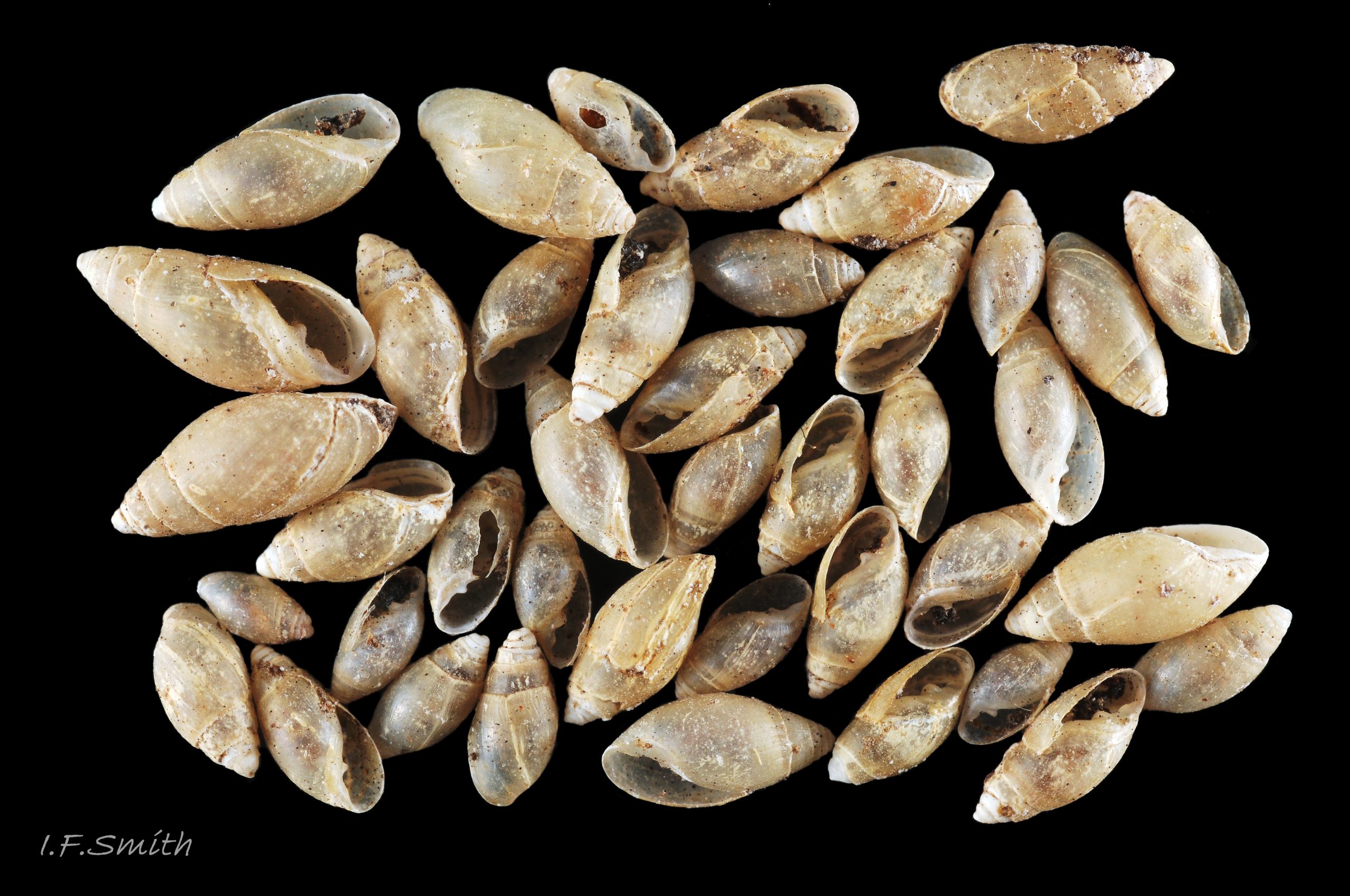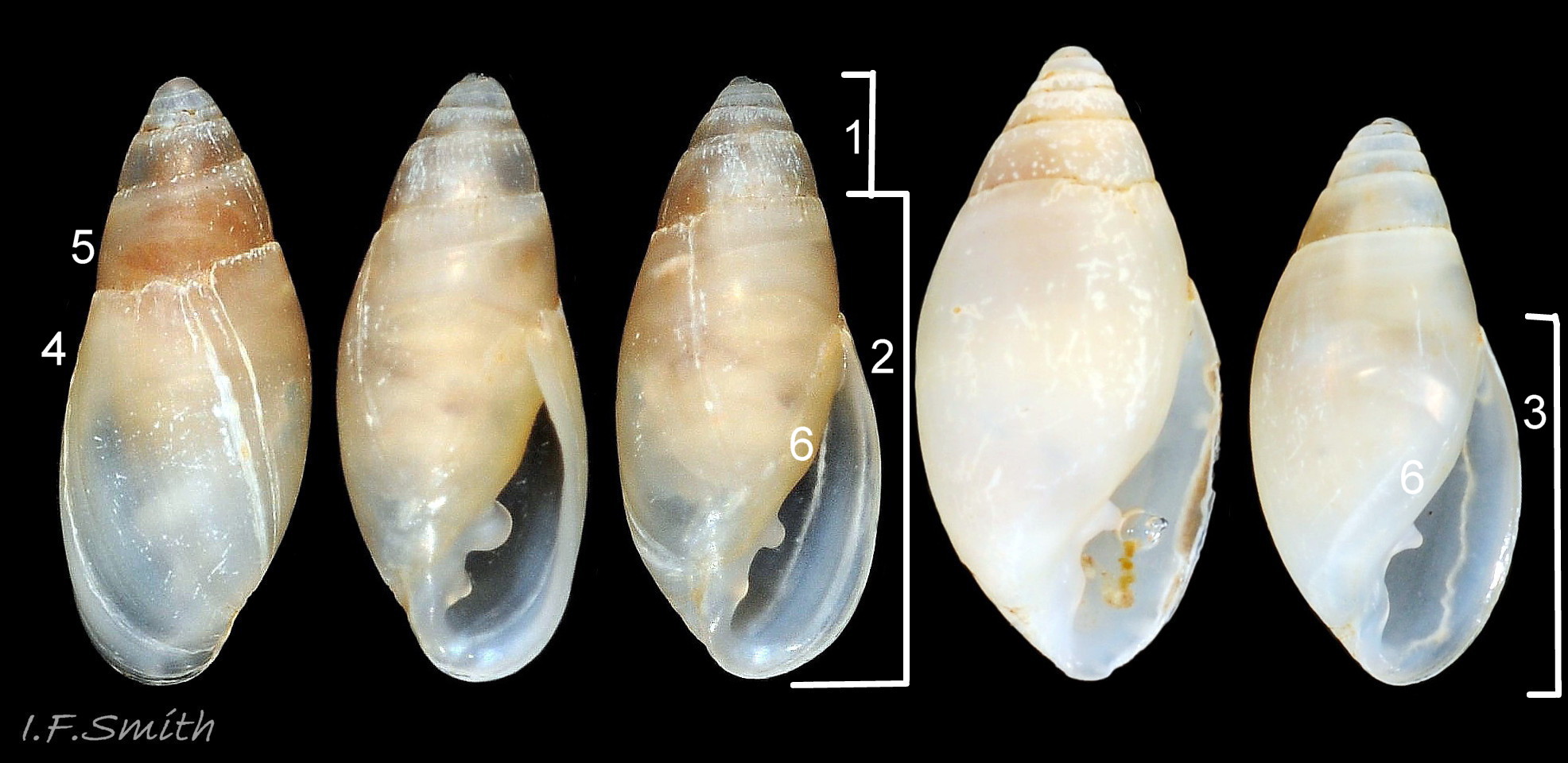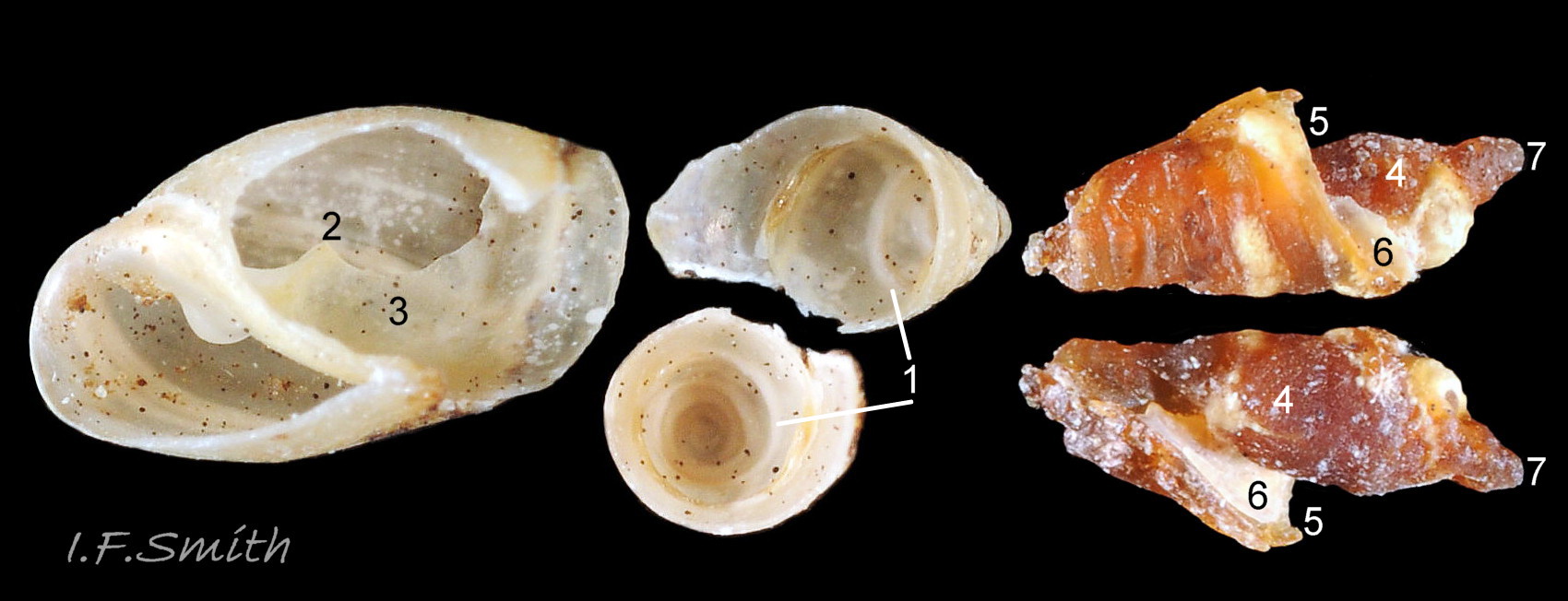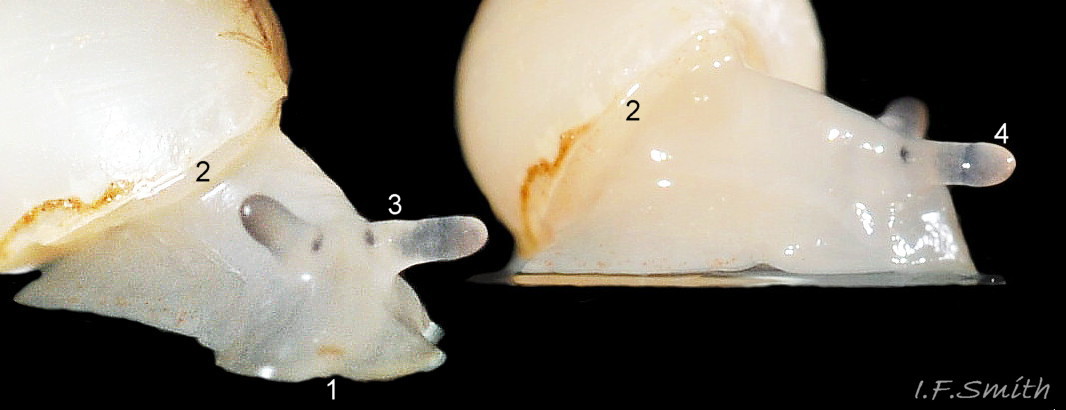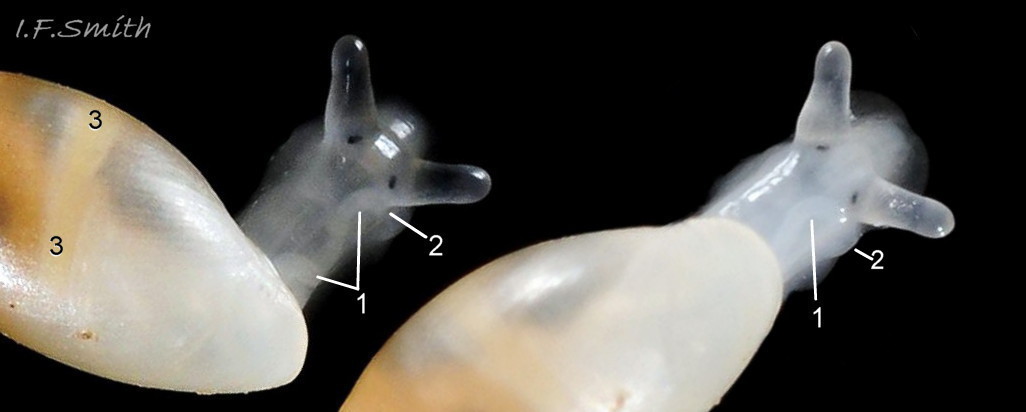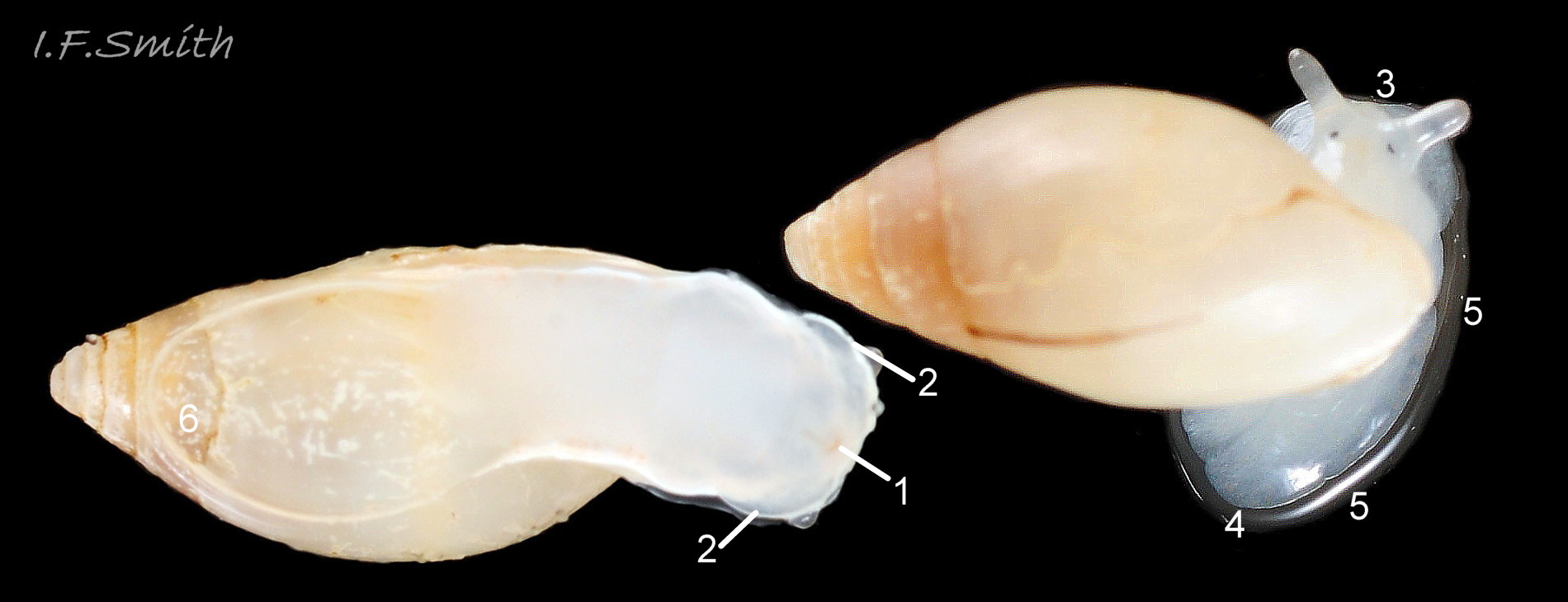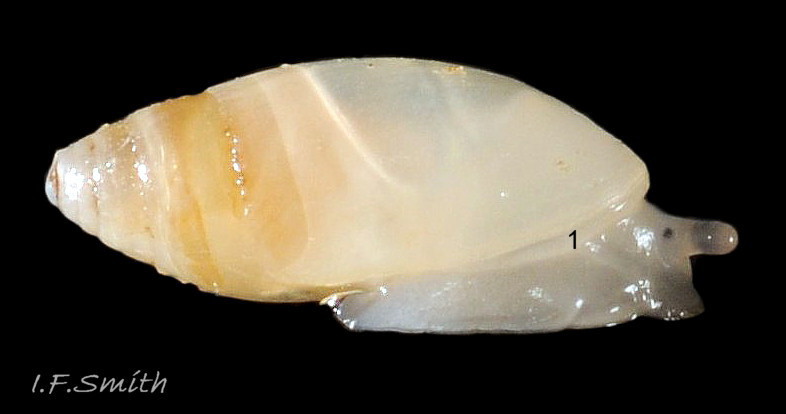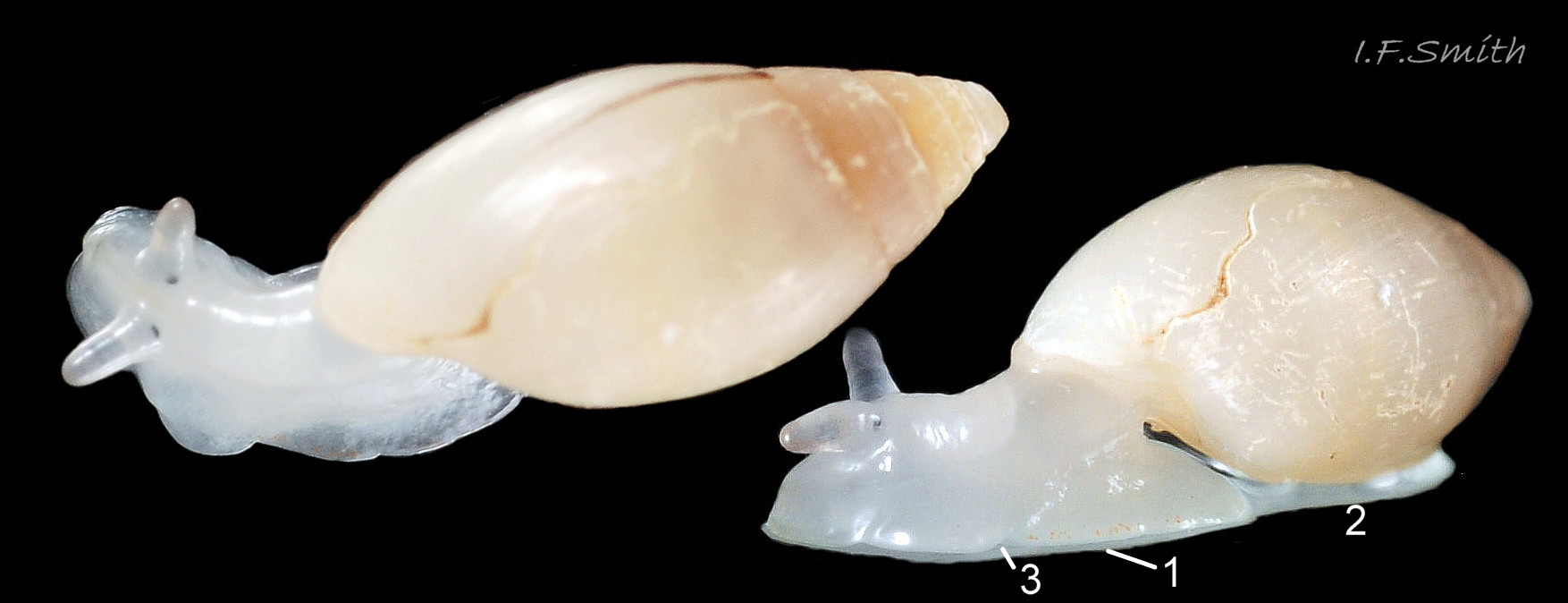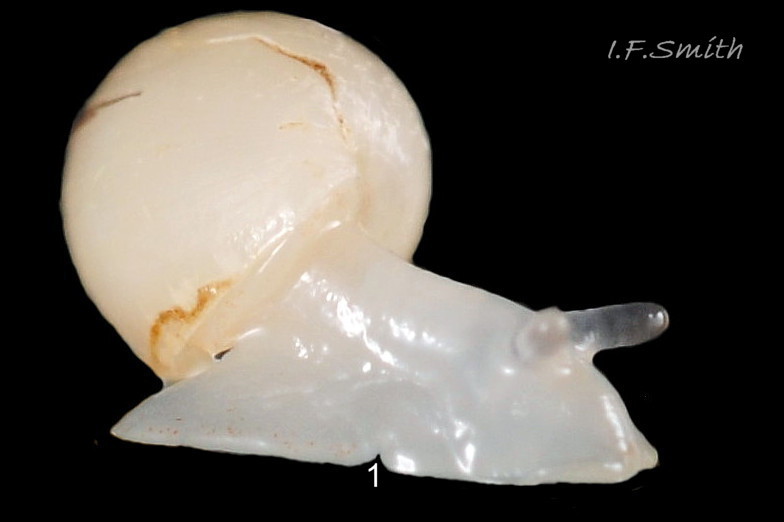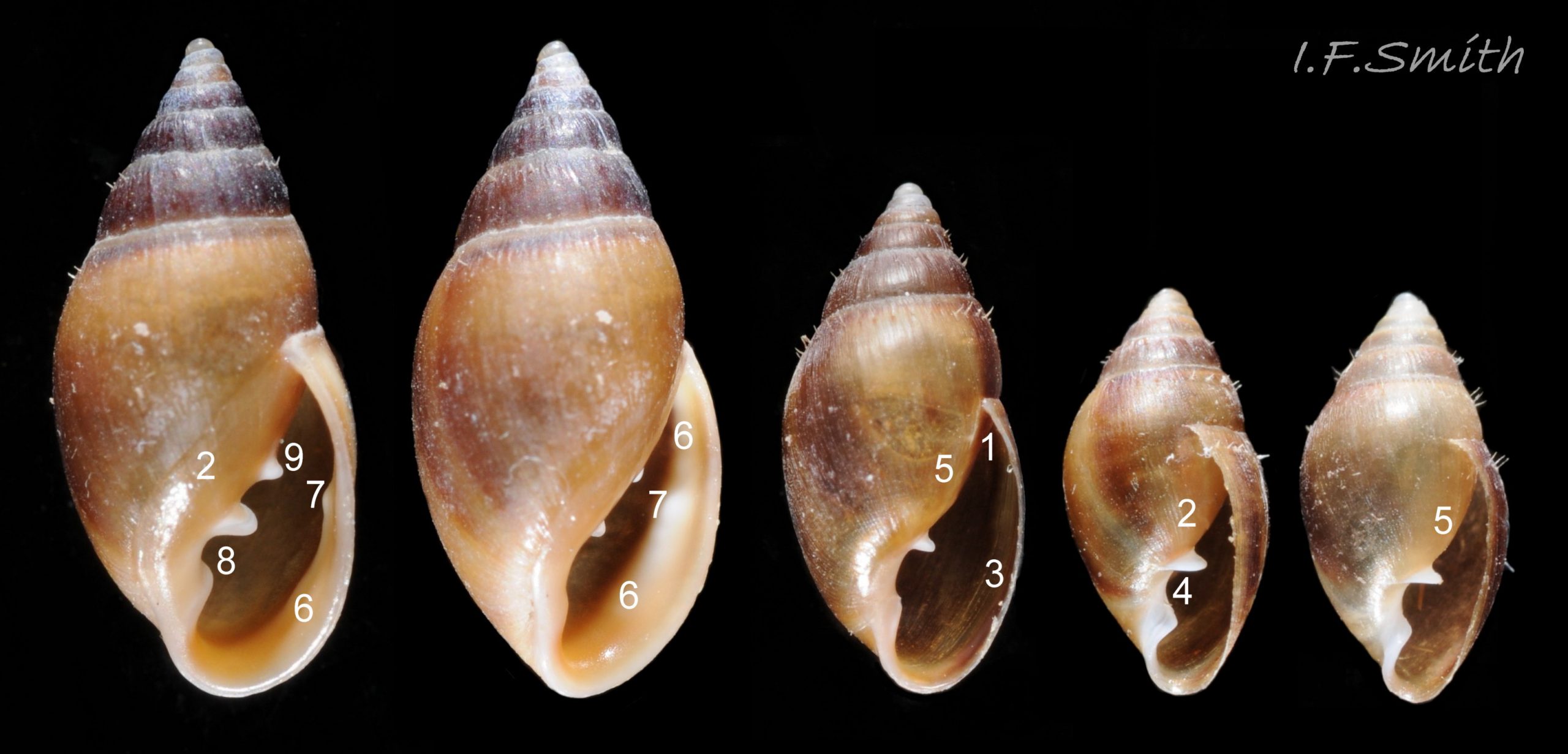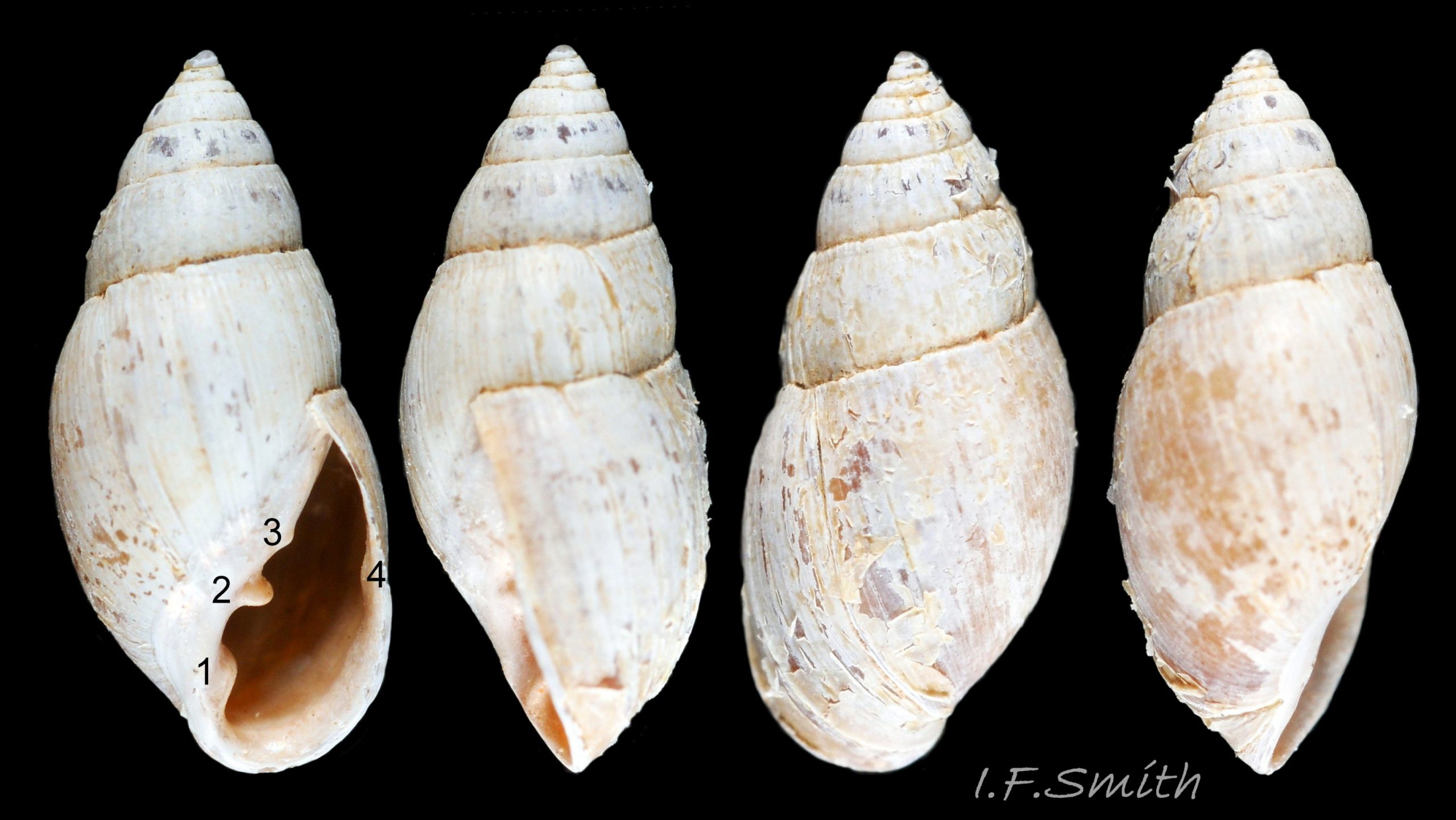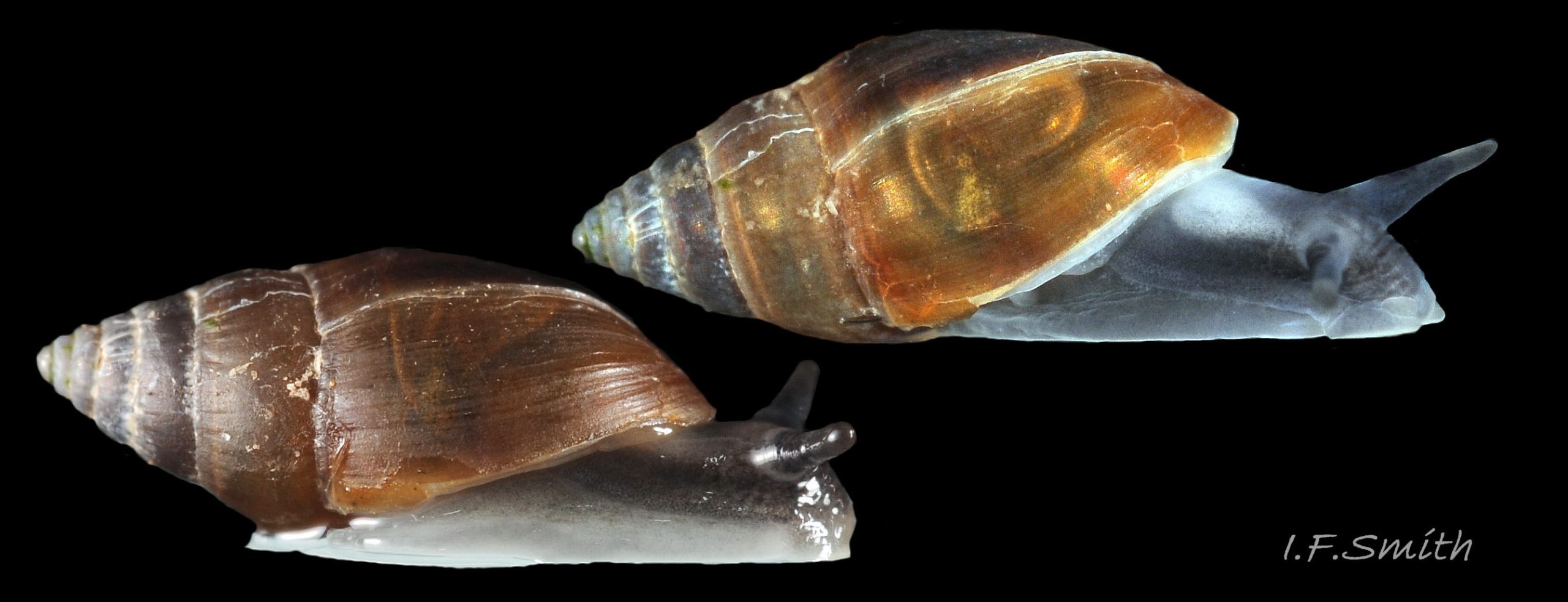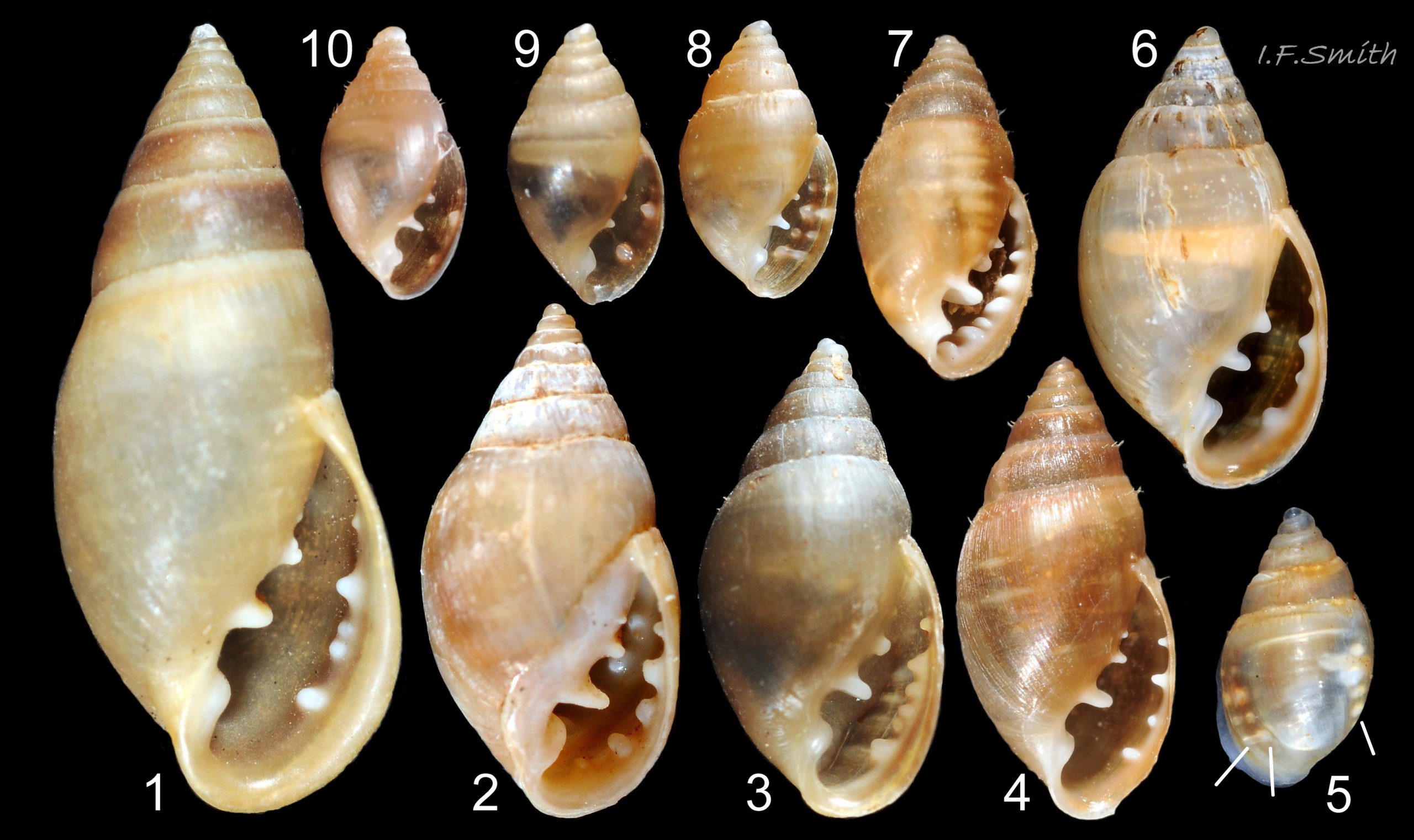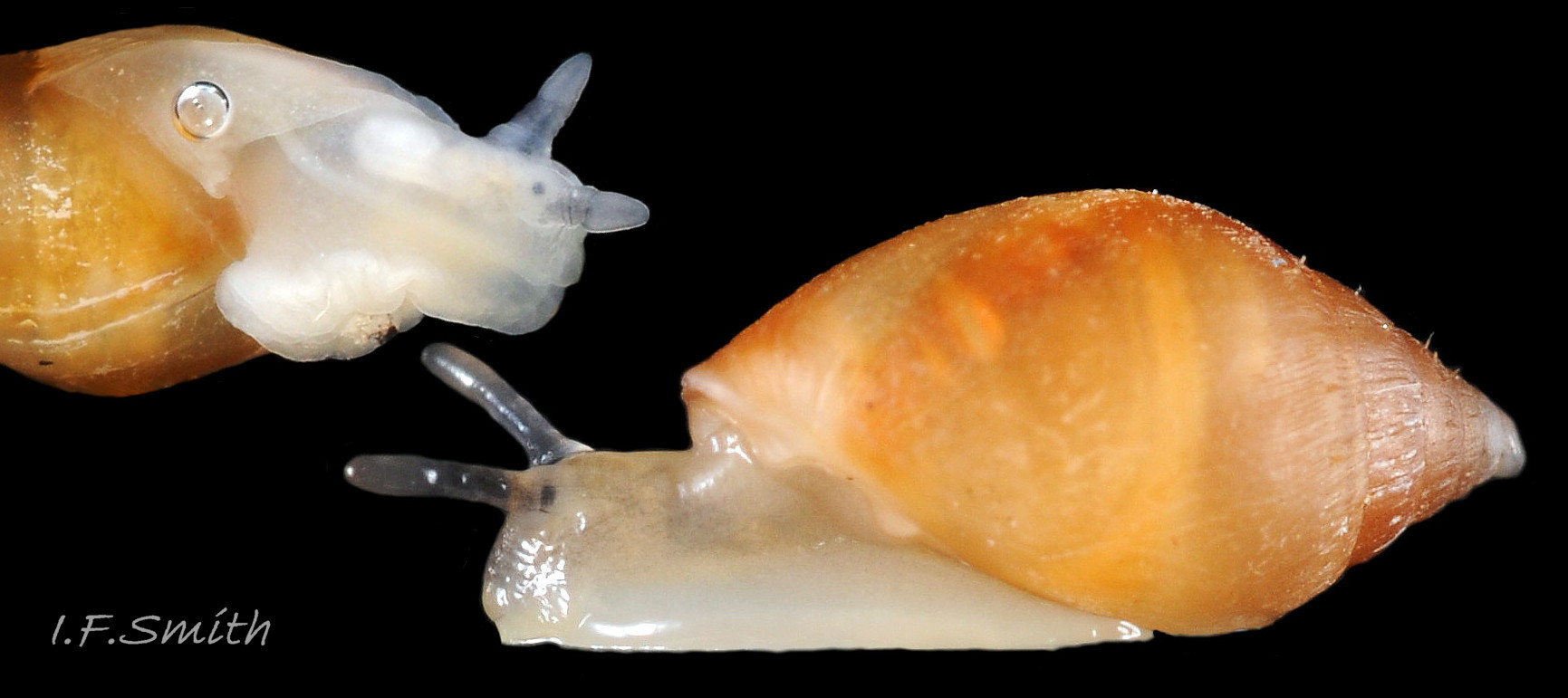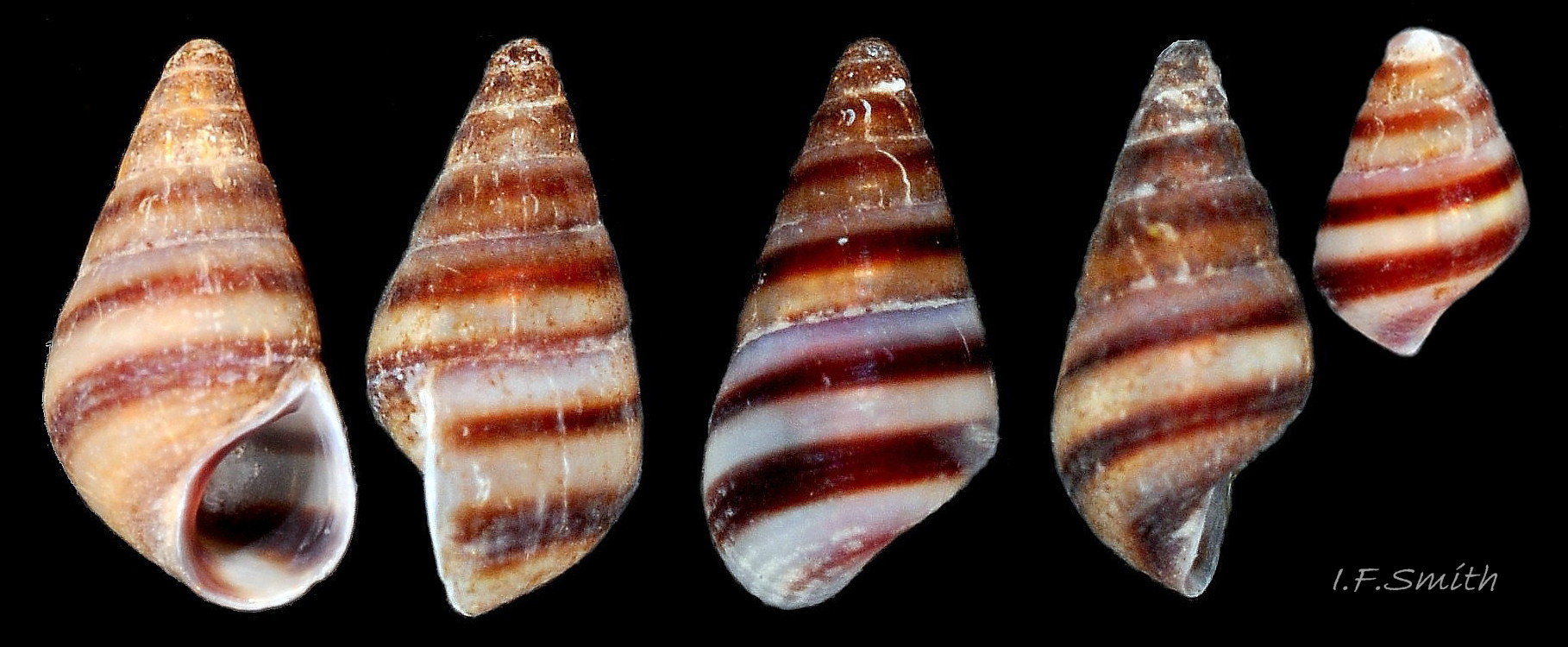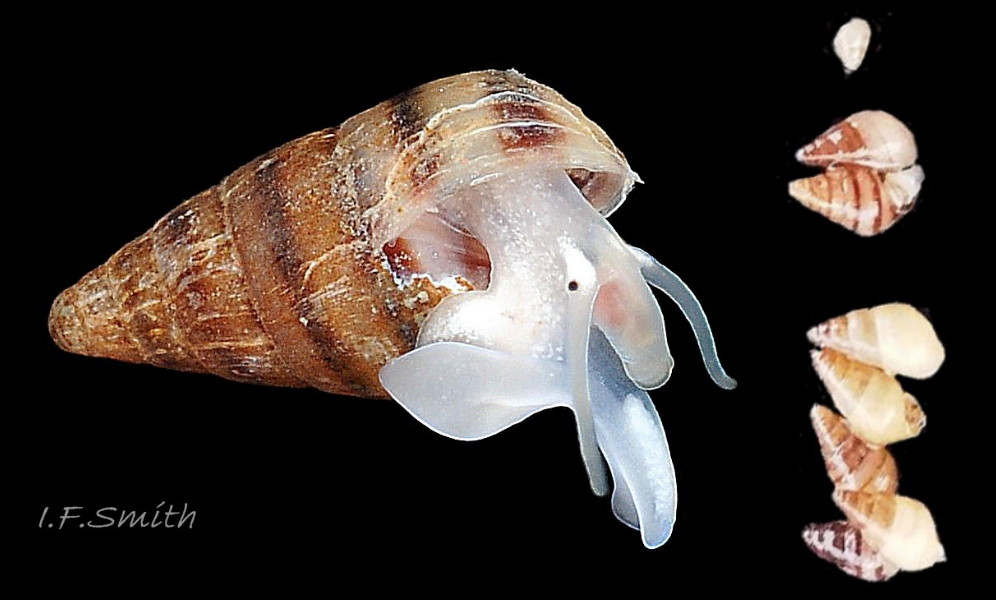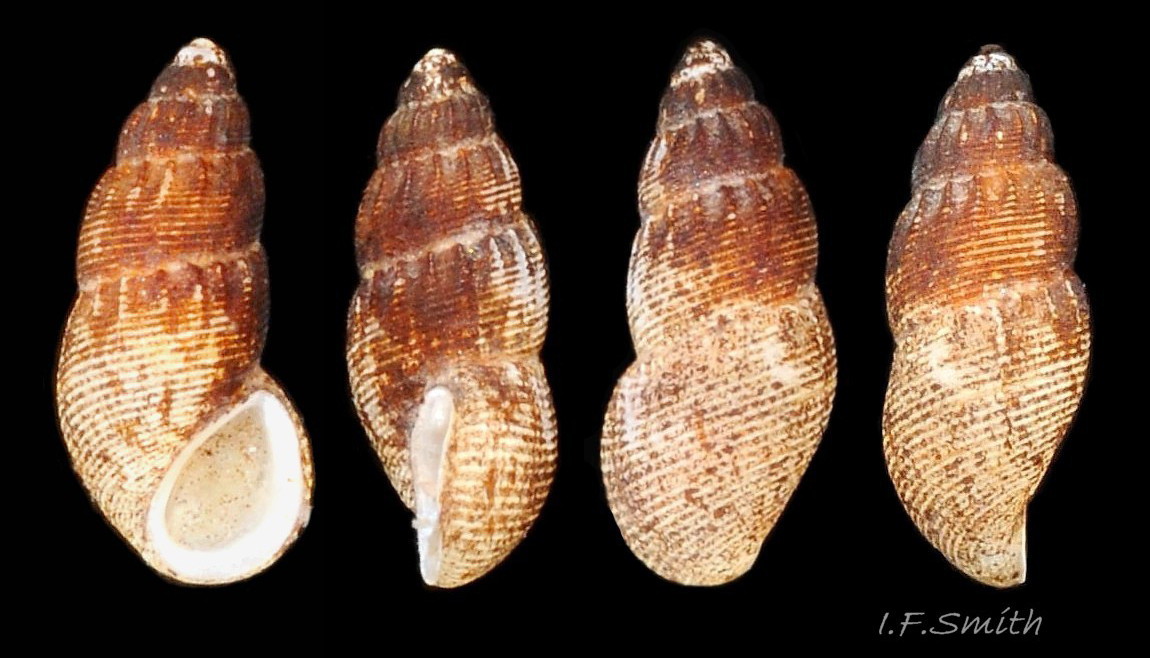Click image to enlarge with full caption. Main text below slider.
Leucophytia bidentata (Montagu, 1808)
Synonyms: Leucophytia bidentata (Montagu, 1808); Leuconia bidentata; Ovatella bidentata; Auriculinella (Leucophytia) erosa (Jeffreys, 1830); Auriculinella bidentata (Montagu, 1808).
Current taxonomy WoRMS: http://www.marinespecies.org/aphia.php?p=taxdetails&id=153949
Vernacular: White mouse-ear; Two-toothed white snail; Wit muizenoortje (Dutch); Zweizahn-Küstenschnecke (German).
GLOSSARY BELOW
Shell description
Maximum height in Britain is 6.5 mm. In a sample of 41 in Orkney, 85% were 3 mm to 4.5 mm high, 5% 5.5 mm high and 10% under 3 mm high 01 Leucophytia bidentata, though smaller specimens were probably commoner but overlooked by the collector. The largest shells in the collections of the National Museum Wales are 6.5 mm high (c. 100 specimens from Britain and Ireland examined; pers. comm. B. Rowson, Feb. 2019). The extreme maximum may be larger in continental Europe; 7 mm in Schultes (2014), but small M. myosotis are often mistaken for L. bidentata, especially when the brown periostracum has been eroded or bleached from old or dead shells. (See appendix below for a misidentification which could have had confusing consequences.) The fairly solid, glossy, slightly translucent, fusiform shell resembles white wax rolled between finger and thumb. Its width is 44% to 50% of the height 02 Leucophytia bidentata. The small spire has a blunt, slightly twisted apex. The body whorl is c. 80% of the shell height. There are up to 6 or 7 slightly convex whorls with a flat subsutural ramp which telescope-like ‘sleeves’ the preceding whorl. The resulting suture is very shallow, but distinct, and often undulates irregularly. The shell surface is smooth except for a few growth lines 02 Leucophytia bidentata.
The thin, varnish-like, faintly yellowish periostracum gives the white shell an ivory colour 02 Leucophytia bidentata, but may darken or be eroded when dead 01 Leucophytia bidentata. When the shell has grown to c. two whorls, the internal columella and the septa in the spire are resorbed by the mantle, leaving an open space except for the columella and septum of the body whorl 03 Leucophytia bidentata.
The aperture is narrow, with a rounded base and a sharp adapical angle of about 10º. Its height is about 60% to 65% of shell height. The palatal (outer) lip is gently bowed, thin and without protrusions (folds/teeth/denticles) 02 Leucophytia bidentata. The wide columellar/parietal lip (inner lip) has only two protrusions with no umbilicus, though Montagu (1808) reported a ‘sub-umbilicus’, see appendix below. The parietal lip consists of a wide glazed area on the body whorl. The interior of the aperture (throat) is smooth and featureless apart from growth lines.
Body description
The head and body are entirely white, except for the watery grey tentacles 04 Leucophytia bidentata. The translucent body reveals few internal organs as most are also translucent white 05 Leucophytia bidentata. Sometimes the reddish brown jaw 04 Leucophytia bidentata & 06 Leucophytia bidentata is visible in the mouth. The mantle often projects a short way beyond the aperture rim of the palatal lip 07 Leucophytia bidentata , but is not reflected onto it. The parietal lip on the body whorl is a glaze formed by the mantle extending onto the whorl. The mantle cavity, which functions as a lung for respiration, is sealed off from the exterior by a thick, white, membranous mantle-collar 04 Leucophytia bidentata. The collar has a pneumostome which can be opened and closed for respiration. The head has two short, nearly cylindrical, semitransparent cephalic tentacles 04 Leucophytia bidentata which have a swollen base and slightly swollen distal half with a hemispherical tip. The tentacles diverge widely from their bases. The distal half of the tentacles is watery grey, sometimes with a pinkish-brown tint, and probably contains sensory chemoreceptor cells. There is an internal, large, black eye within the posteromesial base of each tentacle 05 Leucophytia bidentata. The head has a very short snout which is concealed beneath a pair of broad, rounded, narrowly separated, oral lappets that reach over the front of the head to the substratum (Morton, 1955) 06 Leucophytia bidentata . Unlike the spiral viscera of most gastropods, the viscera of L. bidentata form a non-spiracular, approximate cone 03 Leucophytia bidentata to fill the spire after the columella and septa are resorbed. The translucent white foot varies in shape from broad with a fairly straight anterior and rounded posterior 06 Leucophytia bidentata to elongate, narrow and as long as the shell when fully extended (Morton, 1955). The latter condition was not seen during observations for this account but the cushion of watery mucus under the shell often looked superficially like an elongation of the foot 08 Leucophytia bidentata. The sole is divided by a shallow groove into a semicircular anterior third and a longer posterior section (Morton, 1955) 08 Leucophytia bidentata & 09 Leucophytia bidentata.
L. bidentata is a protandrous hermaphrodite. The penis is a short muscular papilla within a stout, curving, muscular sheath (preputium) which, because it is opaque white, is sometimes visible through the translucent white body 05 Leucophytia bidentata. The preputium opens to the exterior at a small male genital pore behind the right tentacle. For mating, the whole length of the preputium is everted by hydrostatic pressure of haemolymph, though only the small penis enters the partner (Morton, 1955). After mating, the preputium and penis are inverted back into the body by a retractor muscle.
Key identification features
Leucophytia bidentata (Montagu, 1808)
1) White shell with very thin, yellowish-white, varnish-like periostracum creates slightly-translucent ivory-white appearance 02 Leucophytia bidentata. Sutures shallower and whorls less rounded than on M. myosotis. Usual adult height to 5 mm, occasional maximum 6.5 mm.
2) Inner (columellar/parietal) lip has only 2 protrusions within the aperture 02 Leucophytia bidentata.
3) Outer (palatal) lip has no protrusions or rib. Sometimes in a photo, a strong growth line might be mistaken for a rib 02 Leucophytia bidentata.
4) Flesh colour of normally extended dorsal body is almost pure white 08 Leucophytia bidentata ; only grey is on tentacles 04 Leucophytia bidentata. When contracted into body-whorl and viewed through shell, flesh appears cream coloured, and viscera may show yellow to dark orange through spire 02 Leucophytia bidentata.
5. Lives in deep, silty, rock crevices between MHWN and MLWS. Also under stones embedded into soil-like substrate at EHWS level and a little above on sheltered coast where it is often with M. myosotis form denticulata.
Similar species
(Draparnaud, 1801) including form denticulata.
1) Live shell brown 10 Leucophytia bidentata. Beachworn shells, bleached or with worn away periostracum may be dull whitish 11 Leucophytia bidentata .Adult height 3.5 mm to 8 mm, exceptionally 10 mm 13 Leucophytia bidentata.
2) Inner (columellar/parietal) lip has 2 to 5apertural protrusions 10 Leucophytia bidentata & 13 Leucophytia bidentata..
3) Outer (palatal) lip has 0 to 7 (or more) apertural protrusions 13 Leucophytia bidentata, sometimes set by or into a pale ridge which occasionally submerges them 10 Leucophytia bidentata.
N.B., some M. myosotis have 2 protrusions on inner lip and none on outer lip, like L. bidentata, so small, vacant, beachworn shells can be difficult to distinguish from L. bidentata especially in photographs.
4. When under stones on soft substrate, often with L. bidentata, the flesh colour of the normally extended dorsal body is white or very pale whitish grey 12 Leucophytia bidentata with darker grey tentacles 14 Leucophytia bidentata . Shade and intensity varies with age, extension and whether in air or water.
5. Habitat A) among vegetation, often under driftwood, on low salinity estuarine saltings and saltmarsh-grass sward by tidal rivers a little above and below EHWS. Locally abundant.
Habitat B) under slightly embedded stones at EHWS level and above (supralittoral) on sheltered coast without salting vegetation at fully marine salinity or under stones on landward edge of saltmarsh-grass sward by tidal rivers with low salinity. Not usually in crevices.
Cingula trifasciata (J. Adams, 1800)
1) Shell usually whitish with three brown or red-brown spiral bands on body whorl 15 Leucophytia bidentata , but entirely white form occurs 16 Leucophytia bidentata , especially in crevices. Height up to 4.3 mm.
2) Solid, long, conical spire with almost straight sided profile. Not fusiform 15 Leucophytia bidentata .
3) No protrusions within aperture.
4) Flesh translucent white with opaque white eye patches, anterior pedal gland and freckles on upper foot/body. Pink buccal mass visible inside head 16 Leucophytia bidentata .
5) Under embedded stones or in crevices at all tide levels. Often with L. bidentata.
Onoba semicostata (Montagu, 1803)17 Leucophytia bidentata .
1) Shell has many distinct spiral ridges and several subsutural costae. Covered by yellowish, rust-brown or black periostracum that may be partly or completely worn off to reveal white shell beneath.
2) Solid, conical spire with convex whorls and distinct sutures. Not fusiform.
3) No protrusions within aperture.
4) Flesh translucent white with some opaque white and internal pinkish buccal mass.
5) In crevices, often with L. bidentata. Also among weeds, corallines and mussels.
Habits and ecology
Though the respiration of L. bidentata is like that of terrestrial snails, the species is confined to seashores where it lives in two distinct habitats that can maintain a source of atmospheric air; a) rock crevices and b) under rocks embedded in soft substrate.
Crevices. (Morton, 1954, and Glynne-Williams, J. and Hobart, J., 1952). Suitable crevices are most numerous and best developed in hard, foliaceous rocks such as slate and schist. Such crevices are deep, gape less than 5 mm at the entrance, taper inwards, contain saturated sediment in the outer part, and have sticky sediment with air-filled hollows and tunnels in the inner part. Aquatically respiring animals live in the outer saturated part of the crevice, and mainly atmospheric breathers occupy the drier inner part. L. bidentata can survive periods of immersion, so it is an exception in often living equally numerously in both parts of crevices. The surrounding rock preserves the crevices from the environmental extremes of the open seashore and creates an equable environment of constant dark, small temperature and moisture variation and, in the inner part, air with constant 100% relative humidity. If suitable crevices exist, this buffered habitat allows isolated communities of terrestrial organisms to live at nearly all tide levels on a shore. The actual species in both parts of the crevices vary at different shore levels, but L. bidentata has one of the widest tidal ranges, living in crevices from above MHWN down to MLWS. Other molluscs found in the crevices include the aquatically respiring Onoba semicostata , Lasaea rubra and Cingula trifasciata (including the all-white form), and the air breathing Otina ovata, but usually not Myosotella myosotis.
Embedded Stones
L. bidentata also lives on moderately sheltered foreshores under stones embedded into, and in close contact with, soft, soil-like sediment at, and a little above, EHWS. Terrestrial invertebrates such as centipedes, beetles, woodlice and earthworms are often found with it. The worms create dark, humid, air-filled tunnels in the substrate against the underside of the stone. The atmospheric breathing M. myosotis is often with it; neither can live further inland. Unlike crevices, this habitat does not usually extend lower on the shore, probably because water can seep under stones so air pockets cannot be maintained during any but the shortest of immersions at EHWS.
The fusiform (spindle shaped) shell 02 Leucophytia bidentata of L. bidentata is well adapted for movement through the confines of crevices and embedded stones. When moving on smooth surfaces, the foot is cushioned on a layer of watery mucus and the shell has a thicker layer between it and the substrate 06 Leucophytia bidentata & 08 Leucophytia bidentata. Jeffreys (1869) opined that the division of the sole into two lobes 08 Leucophytia bidentata & 09 Leucophytia bidentata indicated that locomotion must resemble the looping action of some caterpillars, but this was contradicted by Morton (1955) who wrote “The two lobes of the foot are structurally very similar, and both are kept on the ground continuously when the animal is crawling. There is no well-marked stepping action as with the divided foot of Otina.” Observations and photographs made for this account support Morton’s assertion.
When feeding, the muzzle is spread out on the substrate and the radula is extended to gather organic detritus (Gittenberger, 2004) with the reddish jaw as a backstop. It has been observed to congregate in captivity on a decaying isopod, possibly feeding (Glynne-Williams & Hobart, 1952). Unlike marine Caenogastropoda gastropods, which defecate into a mantle cavity that is cleared by water currents, L. bidentata has a rectum that opens to the exterior through an anus guarded by a flap in the mantle collar, near to, but separate from, the pneumostome so that faeces are expelled without fouling the respiratory mantle-cavity.
Reproduction: L. bidentata is a protandrous hermaphrodite. At Plymouth, England, sperm is developed primarily from August to December, and oogenesis (egg development) lasts from December to June (Morton, 1955). Copulation occurs from the end of March onwards and oviposition occurs in June. Irregular egg masses, about 4 mm diameter containing 18 to 24 ova, are placed in crevices or under stones by groups of ovipositing snails. Each white-yolked egg is in a blunt-pointed ovoid capsule. The cluster of capsules is held together by a viscid, mucoid secretion which also attaches the mass to the rock surface. The veliger stage is passed within the egg. Small crawling snails emerge at hatching.
Distribution and status
L. bidentata occurs from Shetland, Scotland to the eastern Mediterranean, Canary Islands and Azores. The majority of records are from Britain, Ireland, northern France and Netherlands; GBIF map https://www.gbif.org/species/4304639 . It is widespread around Britain, but has a patchy distribution with some long stretches of coast without record, but it may be overlooked as small and frequently concealed in crevices. There are many records from estuaries in Essex and Suffolk. UK NBN map https://species.nbnatlas.org/species/NHMSYS0000343150
Irish distribution, National biodiversity data centre, in Mollusc Ireland: http://www.habitas.org.uk/molluscireland/species.asp?ID=103
Appendix
Montagu (1808) first described L. bidentata as Voluta bidentata thus, “Shell strong, thick, conic and of a pure white, with six or seven moderately smooth, and somewhat glossy volutions [whorls], wrought with a few distant longitudinal [costal] wrinkles that undulate the separating lines [sutures]; the first [final] or body whirl is two thirds of its length: the apex pointed: aperture narrow, about half the length of the shell, contracted at the upper [adapical] angle; lips thick; columella much thickened, and folding back forms a sub-umbilicus, and is furnished with teeth-like plications. Length a quarter of an inch [6.35 mm]”. Interpolations of more recent/technical terms are in square brackets.
This description accords well with what is currently accepted as L. bidentata except that there is nothing to suggest a ‘sub-umbilicus’ there being no gap behind, or depression in, the wide columellar lip. However his image shows what may be distortion or damage to the lip which may be that feature. His type specimens were kept in the Royal Albert Memorial Museum, Exeter, England, but have since been crushed beyond recognition and a specimen of M. myosotis substituted in error by an unknown person. For further detail, scroll down to ‘Notes’ at https://gbmolluscatypes.ac.uk/specimens/121 which shows an image of the misidentified M. myosotis with brown periostracum and three denticles/folds accompanied by the card with the adhering fragments of the true type.
Acknowledgements
I gratefully thank Ben Rowson of Amgueddfa Cymru (National Museum of Wales) for help.
References and links
Ablett J., Brown C., Carnall, M., Charmantier, I., Chatfield, J., Gallichan J., Geraghty, A., Gordon D., Holmes A. M., Hunter T., Ismail, L., Large, L., Lewis, M., Machin R., Middleton, J., Morgenroth H., Oliver P. G., Petts R., Picton, B., Pye S., Reilly M., Rowson B., Rowson, R., Salvador A., Sutcliffe R., Turner J. A., Viscardi, P., Wallace, I., White, T., & Wood H. 2023. Mollusca Types in Britain and Ireland. Amgueddfa Cymru – National Museum Wales / Natural History Museum. https://gbmolluscatypes.ac.uk
Anderson, R. MolluscIreland, accessed February 2019. http://www.habitas.org.uk/molluscireland/species.asp?ID=103
Forbes, E. & Hanley S. 1849-53. A history of the British mollusca and their shells. vol. 4 (1853). London, van Voorst. (As Conovulus bidentatus.)
https://archive.org/details/historyofbritish04forbe/page/190
plate CXXV https://archive.org/details/historyofbritish04forbe/page/n565
Fretter, V. & Peake, J. 1975. Pulmonates functional anatomy and physiology. Vol.1. London. Academic Press.
Gittenberger, E. et al. 2004. De Nederlandse zoetwatermollusken. Leiden, Netherlands, Nationaal Natuurhistorisch Museum Naturalis.
Glynne-Williams, J. and Hobart, J. 1952. Studies on the crevice fauna of a selected shore in Anglesey. Proc. Zool. Soc. 122: 797 to 218.
Abstract at https://doi.org/10.1111/j.1096-3642.1952.tb00249.x
Heller J. 2015. Marine Ancestors of most Land Snails: Pulmonates. In: Sea Snails. Springer, Cham. Abstract at https://link.springer.com/chapter/10.1007%2F978-3-319-15452-7_10
Jeffreys, J.G. 1862-69. British conchology. vol. 5 (1869). London, van Voorst. (As Melampus bidentatus) https://archive.org/stream/britishconcholog05jeffr#page/104/mode/2up
Mollusca types in Britain and Ireland https://gbmolluscatypes.ac.uk/
Montagu, G. 1808. Supplement to: 1803 Testacea Britannica, or, Natural history of British shells, marine, land, and fresh-water, including the most minute : systematically arranged and embellished with figures. London, J. White. as Voluta bidentata pp. 100-101. https://www.biodiversitylibrary.org/page/61685744#page/114/mode/1up
Plate 30, fig. 2: https://www.biodiversitylibrary.org/page/61685744#page/225/mode/1up
Morton, J.E. 1954. The crevice faunas of the upper intertidal zone at Wembury. J. Mar. biol. Ass. U.K. 33: 187 – 224. http://plymsea.ac.uk/view/year/1954.html#group_M
Morton, J. E. 1955. The functional morphology of the British Ellobiidae (Gastropoda Pulmonata) with special reference to the digestive and reproductive systems. Phil. Trans. R. Soc. Ser. B . 239, No. 661: 89-160 http://www.jstor.org/stable/92507
Glossary
adapical angle = angle at which outer lip meets body-whorl.
Caenogastropoda = Littorinimorpha and Neogastropoda; mostly sea snails. Combined with the Patellogastropoda they formed most of the now unaccepted Prosobranchia in the Twentieth Century.
coll. = (or “in coll.”, abbreviation of “in collectionem”) in the collection of (named person or institution; compare with leg.).
columella = solid or hollow axial “little column” around which gastropod shell spirals; hidden inside shell, except on final whorl next to lower part of inner lip of aperture.
columellar = (adj.) of or near central axis of coiled gastropod.
columellar lip = lower (abapical) part of inner lip of aperture.
costa = (pl. costae) rib running across a whorl of a gastropod shell at approximately right-angles to direction of coiling and any spiral striae.
costal = (adj.) of, or arranged like, costae.
distal = away from centre of body or from point of attachment.
everted = turned outside out and, like a sock, capable of turning outside in (inverted).
EHWS = extreme high water spring tide.
fusiform = slender, spindle-shaped/ cigar shaped, tapering almost equally towards both ends. [fusus = ‘spindle’ in Latin].
foliaceous rock = rock consisting of thin leaf-like layers such as slate and schist.
haemolymph = circulating fluid in molluscs that carries nutrients, waste and hormones. Analagous to vertebrate blood, but most molluscs have copper-based haemocyanin in it instead of red haemoglobin to carry oxygen.
leg. = (abbreviation of legit) collected/ found by (compare with coll.)
mantle = sheet of tissue that secretes the shell, covers the viscera and forms a cavity in gastropods. In L. bidentata the cavity roof contains a network of haemolymph vessels enabling the cavity to act like a lung.
mesial = on or facing towards the midline of the body.
MHWN = mean high water neap tide level (mean level reached by weakest high tides for a few days every fortnight. i.e. those that rise the least).
MLWS = mean low water spring tide level (mean level reached by lowest low tides for a few days every fortnight, Laminaria or Coralline zone on rocky coasts).
operculum = plate of horny conchiolin used to close shell aperture of Caenogastropoda gastropods.
palatal lip = outer lip of gastropod aperture.
parietal lip ( or parietal wall) = upper part of inner side of gastropod aperture, often lacking clear lip structure with just a glaze on side of whorl adapically of columellar lip.
periostracum = thin horny layer of proteinaceous material often coating shells.
pneumostome = external respiratory opening of atmospheric air-breathing mollusc.
posteromesial = at the rear facing towards the midline of the body.
protandrous hermaphrodite = each individual starts mature life as a functioning male, later changing to female function.
protoconch = apical whorls produced during embryonic and larval stages of gastropod; often different in form from other whorls (teleoconch).
protrusions = teeth, denticles, folds, lamellae or cogs (terms used by various authors).
preputium = prepuce, foreskin of penis.
resorb = absorb what was previously secreted; break it down into component materials and disperse into the circulation.
resorption = the process of absorbing what was previously secreted by breaking it down into component materials and dispersal into the circulation.
salting = area of salt tolerant vascular plants rooted in sediment between mean high water mark (MHW) and extreme high water of spring tides (EHWS). [Preferred synonym for “saltmarsh” as much of salting not marshy.]
septum = (pl. septa) internal partition separating two chambers/ shell-whorls of a gastropod.
subsutural = close below the suture when shell positioned with apex uppermost.
suture = groove or line where whorls of gastropod shell adjoin.
teleoconch = entire gastropod shell other than the apical, embryonic & larval stage protoconch.
